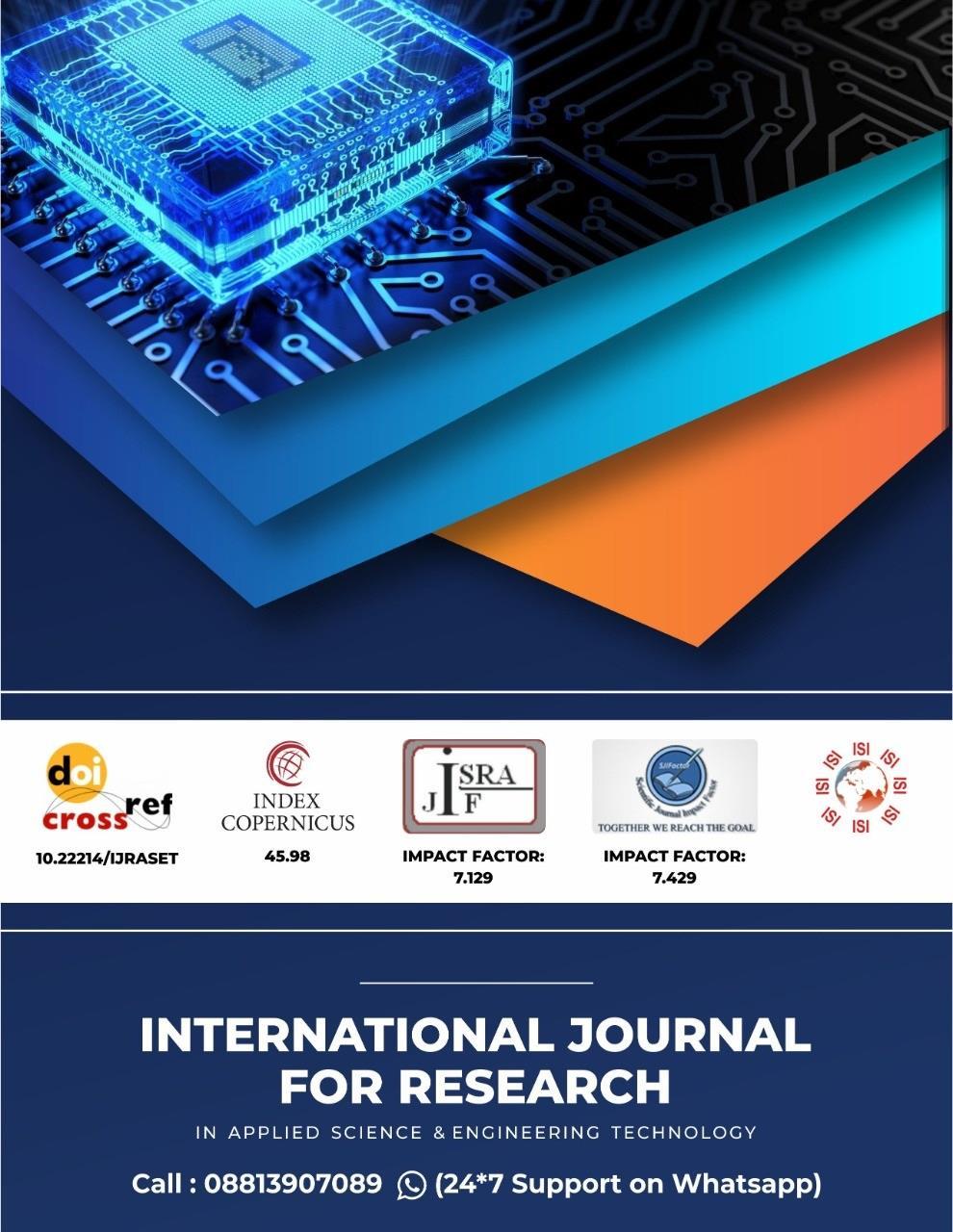https://doi.org/10.22214/ijraset.2023.48862

ISSN: 2321-9653; IC Value: 45.98; SJ Impact Factor: 7.538
Volume 11 Issue I Jan 2023- Available at www.ijraset.com

https://doi.org/10.22214/ijraset.2023.48862

ISSN: 2321-9653; IC Value: 45.98; SJ Impact Factor: 7.538
Volume 11 Issue I Jan 2023- Available at www.ijraset.com
2, 3
Student, 4
Professor, Department of Electronics and Communication Engineering, Sreenidhi Institute of Science and Technology, Ghatkesar, Hyderabad, India
Abstract: Doorbells are usual signaling devices used to alert the person inside the building to open the door as someone has arrived. Classic doorbells can be seen in every house now a days, which uses simple button and when that button is pressed the bell rings. The doorbell which we are going to make is different from that. We will make a doorbell which is automatic, i.e. it will detect someone in front of it and then it will ring. We will be using a very simple circuit to implement this project. This project can be really beneficial because it’s not always the case that a person can reach the doorbell, so it would be nice if it rings automatically after detecting the person.
Also, there is a flexibility that you can adjust the distance according to you by doing some changes in the code you are using to drive the doorbell.We will be using ultrasonic sensor to detect the person and then give the alert using a buzzer.
As we know that ultrasonic sensors are used for distance measurement without physical contact for small distances. So it’s the best thing to use ultrasonic sensor for detecting object.
A. Defining Arduino Uno
An Arduino is actually a microcontroller based kit which can be either used directly by purchasing from the vendor or can be made at home using the components, owing to its open source hardware feature. It is basically used in communications and in controlling or operating many devices.
1) Digital pins: 14 (These pins have only 2 states i.e. high or low or in simple words either 5 V or 0 V no in between values. These pins are mostly used to sense the voltage presence when switch is open or close)
2) Analog pins: 6 (A0 to A5 and they come up with a resolution of 10 bits and they provide flexibility of connecting any external device via these pins. These pins are configured from 0 V to 5 V but they can be configured to high range by using AREF pin or analogReference () function. ADC (analog to digital convertor) is used to sample these pins. These pins take analog signal and by using ADC convertor they convert this analog signal to number between 0 – 1023)
3) 16 MHz crystal oscillator

4) Out of 14 digital pins, 6 can be used for PWM (pulse width modulation)
5) USB port
6) TX and RX pins (for serial communication)
7) Arduino is an open-source hardware and software company, project and user community that designs and manufactures single-board microcontrollers and microcontroller kits for building digital devices. Its products are licensed under the GNU Lesser General Public License (LGPL) or the GNU General Public License (GPL), permitting the manufacture of Arduino boards and software distribution by anyone. Arduino boards are available commercially in preassembled form or as do-ityourself (DIY) kits.
8) Arduino board designs use a variety of microprocessors and controllers. The boards are equipped with sets of digital and analog input/output (I/O) pins that may be interfaced to various expansion boards ('shields') or breadboards (For prototyping) and other circuits. The boards feature serial communications interfaces, including Universal Serial Bus (USB) on some models, which are also used for loading programs from personal computers. The microcontrollers can be programmed using C and C++ programming languages. In addition to using traditional compiler toolchains, the Arduino project provides an integrated development environment (IDE) based on the Processing language project.
9) The Arduino project started in 2005 as a program for students at the Interaction Design Institute Ivrea in Ivrea, Italy, aiming to provide a low-cost and easy way for novices and professionals to create devices that interact with their environment using sensors and actuators. Common examples of such devices intended for beginner hobbyists include simple robots, thermostats and motion detectors.
ISSN: 2321-9653; IC Value: 45.98; SJ Impact Factor: 7.538

Volume 11 Issue I Jan 2023- Available at www.ijraset.com
10) The name Arduino comes from a bar in Ivrea, Italy, where some of the founders of the project used to meet. The bar was named after Arduin of Ivrea, who was the margrave of the March of Ivrea and King of Italy from 1002 to 1014.
The Arduino project was started at the Interaction Design Institute Ivrea (IDII) in Ivrea, Italy. At that time, the students used a BASIC Stamp microcontroller at a cost of $50, a considerable expense for many students. In 2003 Hernando Barragán created the development platform Wiring as a Master's thesis project at IDII, under the supervision of Massimo Banzi and Casey Reas. Casey Reas is known for cocreating, with Ben Fry, the Processing development platform. The project goal was to create simple, low cost tools for creating digital projects by non-engineers. The Wiring platform consisted of a printed circuit board (PCB) with an ATmega168 microcontroller, an IDE based on Processing and library functions to easily program the microcontroller. In 2005, Massimo Banzi, with David Mellis, another IDII student, and David Cuartielles, added support for the cheaper ATmega8 microcontroller to Wiring. But instead of continuing the work on Wiring, they forked the project and renamed it Arduino.The initial Arduino core team consisted of Massimo Banzi, David Cuartielles, Tom Igoe, Gianluca Martino, and David Mellis, but Barragán was not invited to participate.
Following the completion of the Wiring platform, lighter and less expensive versions were distributed in the open-source community. It was estimated in mid-2011 that over 300,000 official Arduinos had been commercially produced, and in 2013 that 700,000 official boards were in users' hands.
In October 2016, Federico Musto, Arduino's former CEO, secured a 50% ownership of the company. In April 2017, Wired reported that Musto had "fabricated his academic record On his company's website, personal LinkedIn accounts, and even on Italian business documents, Musto was until recently listed as holding a PhD from the Massachusetts Institute of Technology. In some cases, his biography also claimed an MBA from New York University." Wired reported that neither university had any record of Musto's attendance, and Musto later admitted in an interview with Wired that he had never earned those degrees. Around that same time, Massimo Banzi announced that the Arduino Foundation would be "a new beginning for Arduino. But a year later, the Foundation still hasn't been established, and the state of the project remains unclear. The controversy surrounding Musto continued when, in July 2017, he reportedly pulled many Open source licenses, schematics, and code from the Arduino website, prompting scrutiny and outcry.
In October 2017, Arduino announced its partnership with ARM Holdings (ARM). The announcement said, in part, "ARM recognized independence as a core value of Arduino ... without any lock-in with the ARM architecture.” Arduino intends to continue to work with all technology vendors and architectures.

Arduino is open-source hardware. The hardware reference designs are distributed under a Creative Commons
Attribution Share-Alike 2.5 license and are available on the Arduino website. Layout and production files for some versions of the hardware are also available. Although the hardware and software designs are freely available under copyleft licenses, the developers have requested the name Arduino to be exclusive to the official product and not be used for derived works without permission. The official policy document on use of the Arduino name emphasizes that the project is open to incorporating work by others into the official product. Several Arduino-compatible products commercially released have avoided the project name by using various names ending in -duino Most Arduino boards consist of an Atmel 8bit AVR microcontroller (ATmega8, ATmega168, ATmega328, ATmega1280, or ATmega2560) with varying amounts of flash memory, pins, and features. The 32-bit Arduino Due, based on the Atmel SAM3X8E was introduced in 2012. The boards use single or double-row pins or female headers that facilitate connections for programming and incorporation into other circuits. These may connect with add-on modules termed shields Multiple and possibly stacked shields may be individually addressable via an I²C serial bus. Most boards include a 5 V linear regulator and a 16 MHz crystal oscillator or ceramic resonator. Some designs, such as the Lily Pad, run at 8 MHz and dispense with the onboard voltage regulator due to specific form-factor restrictions.
Arduino microcontrollers are preprogrammed with a boot loader that simplifies uploading of programs to the on-chip flash memory. The default bootloader of the Arduino Uno is the Optiboot bootloader. Boards are loaded with program code via a serial connection to another computer. Some serial Arduino boards contain a level shifter circuit to convert between RS-232 logic levels and transistor–transistor logic (TTL) level signals.
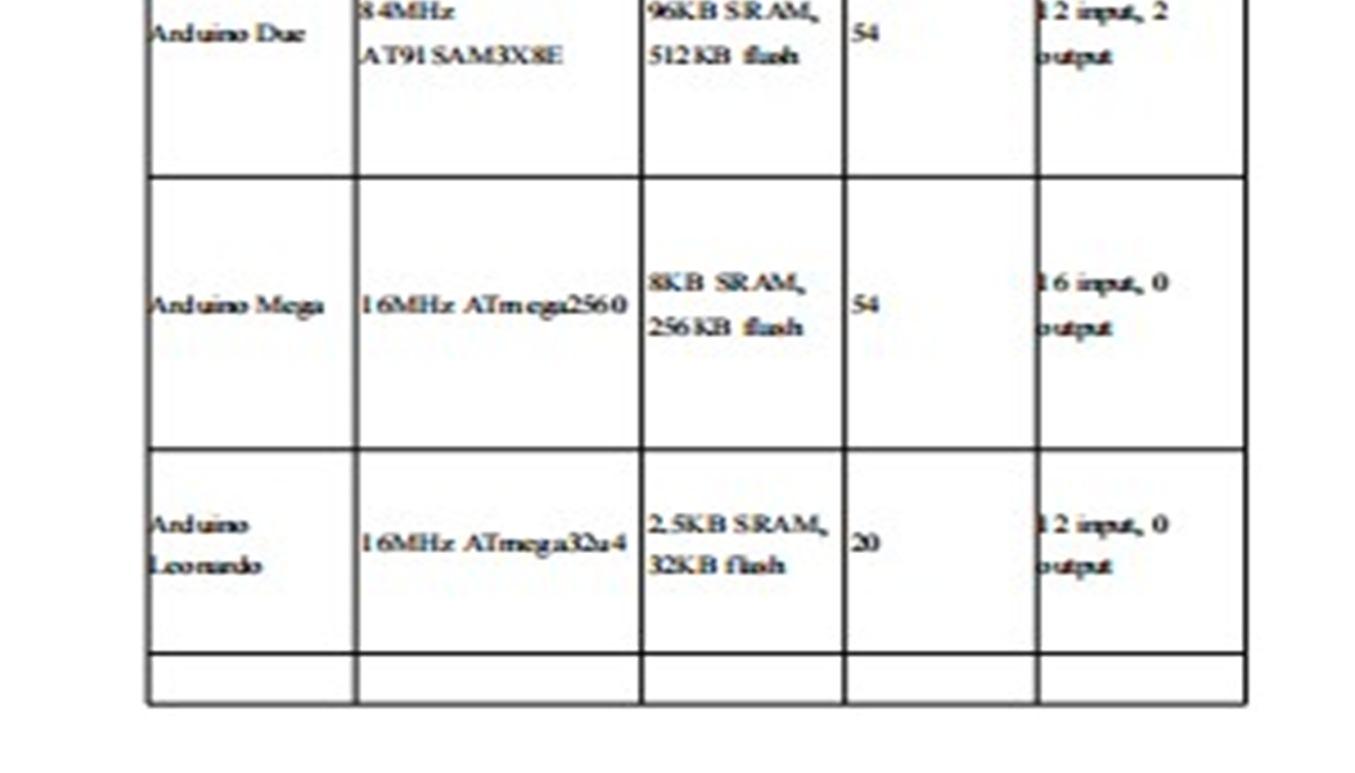

ISSN: 2321-9653; IC Value: 45.98; SJ Impact Factor: 7.538
Volume 11 Issue I Jan 2023- Available at www.ijraset.com
Current Arduino boards are programmed via Universal Serial Bus (USB), implemented using USB-to-serial adapter chips such as the FTDI FT232. Some boards, such as later-model Uno boards, substitute the FTDI chip with a separate AVR chip containing USB-to-serial firmware, which is reprogrammable via its own ICSP header. Other variants, such as the Arduino Mini and the unofficial Boarduino, use a detachable ix | P a g ex | P a g e
USB-to-serial adapter board or cable, Bluetooth or other methods. When used with traditional microcontroller tools, instead of the Arduino IDE, standard AVR in-system programming (ISP) programming is used.
The Arduino board exposes most of the microcontroller's I/O pins for use by other circuits. The Diecimila,[a] Duemilanove,[b] and current Uno[c] provide 14 digital I/O pins, six of which can produce pulse-width modulated signals, and six analog inputs, which can also be used as six digital I/O pins. These pins are on the top of the board, via female 0.1-inch (2.54 mm) headers. Several plugin application shields are also commercially available. The Arduino Nano, and Arduino-compatible Bare Bones Board and Boarduino boards may provide male header pins on the underside of the board that can plug into solderless breadboards. Many Arduino-compatible and Arduinoderived boards exist. Some are functionally equivalent to an Arduino and can be used interchangeably. Many enhance the basic Arduino by adding output drivers, often for use in school-level education, to simplify making buggies and small robots. Others are electrically equivalent, but change the form factor, sometimes retaining compatibility with shields, sometimes not. Some variants use different processors, of varying compatibility.

1) Arduino Uno
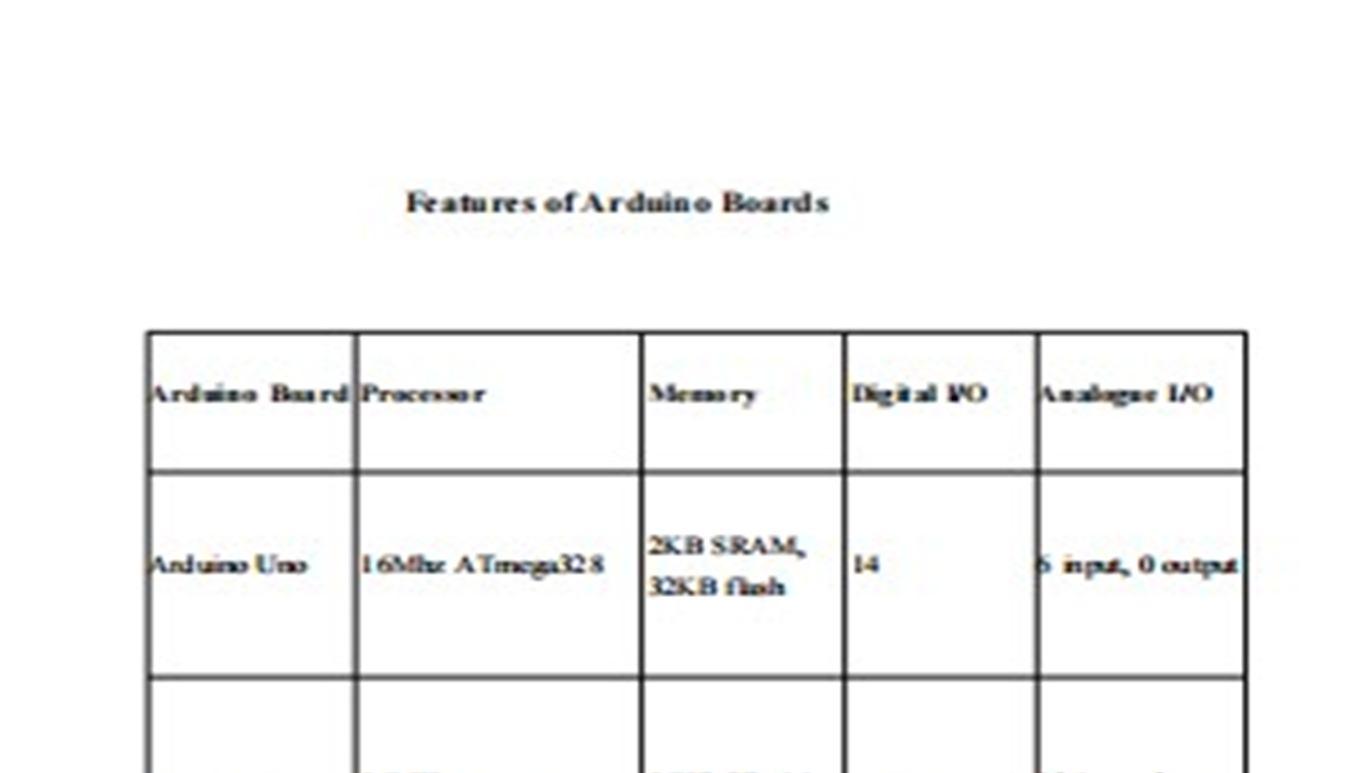
2) Arduino due
3) Arduino Mega (R3)
4) Arduino Leonardo
ISSN: 2321-9653; IC Value: 45.98; SJ Impact Factor: 7.538

Volume 11 Issue I Jan 2023- Available at www.ijraset.com

The Uno is a huge option for your initial Arduino. It consists of 14-digital I/O pins, where 6-pins can be used as PWM(pulse width modulation outputs), 6-analog inputs, a reset button, a power jack, a USB connection and more. It includes everything required to hold up the microcontroller; simply attach it to a PC with the help of a USB cable and give the supply to get started with a AC-toDC adapter or battery

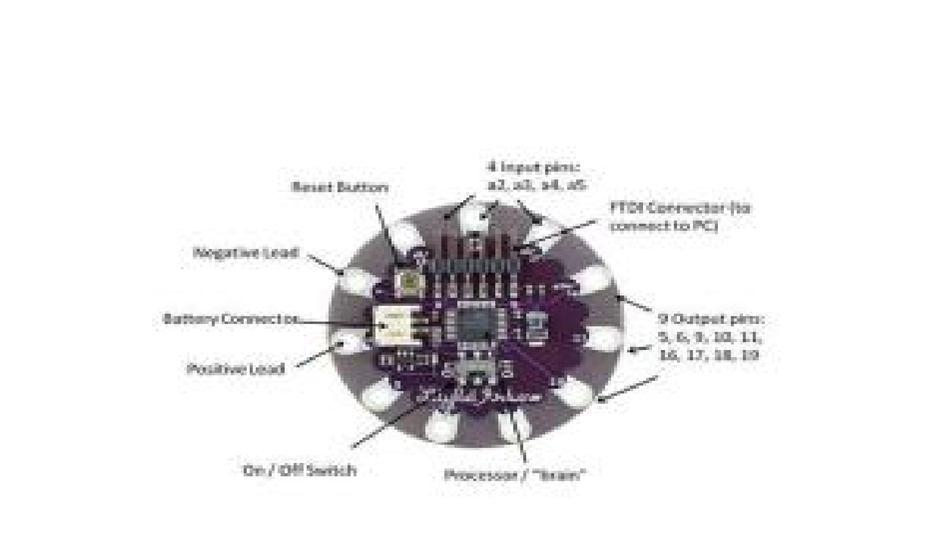
The Lily Pad Arduino board is a wearable etextile technology expanded by Leah “ Buechley” and considerately designed by “Leah and SparkFun”. Each board was imaginatively designed with huge connecting pads & a smooth back to let them to be sewn into clothing using conductive thread. This Arduino also comprises of I/O, power, and also sensor boards which are built especially for e-textiles. These are even washable!
The Arduino Mega is similar to the UNO’s big brother. It includes lots of digital I/O pins (from that, 14-pins can be used as PWM o/ps), 6-analog inputs, a reset button, a power jack, a USB connection and a reset button. It includes everything required to hold up the microcontroller; simply attach it to a PC with the help of a USB cable and give the supply to get started with a AC-to-DC adapter or battery.The huge number of pins make this Arduino board very helpful for designing the projects that need a bunch of digital i/ps or o/ps like lots buttons.
The first development board of an Arduino is the Leonardo board. This board uses one microcontroller along with the USB. That means, it can be very simple and cheap also. Because this board handles USB directly, program libraries are obtainable which let the Arduino board to follow a keyboard of the computer, mouse, etc.
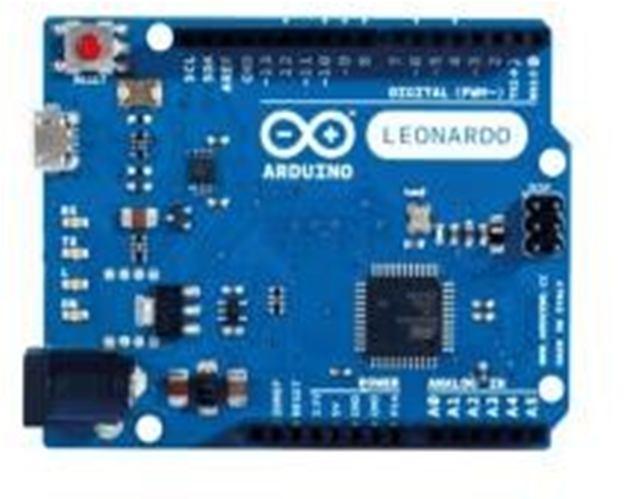

ISSN: 2321-9653; IC Value: 45.98; SJ Impact Factor: 7.538
Volume 11 Issue I Jan 2023- Available at www.ijraset.com
The Decoder IC, then decodes the serial data to parallel data and transmits the Logic ‘0’ to Arduino. In the Arduino UNO's, it is programmed such that, whenever a Logic '0' is detected by the Arduino, the buzzer is turned on. Hence, whenever the button is pressed, the buzzer is turned on wirelessly

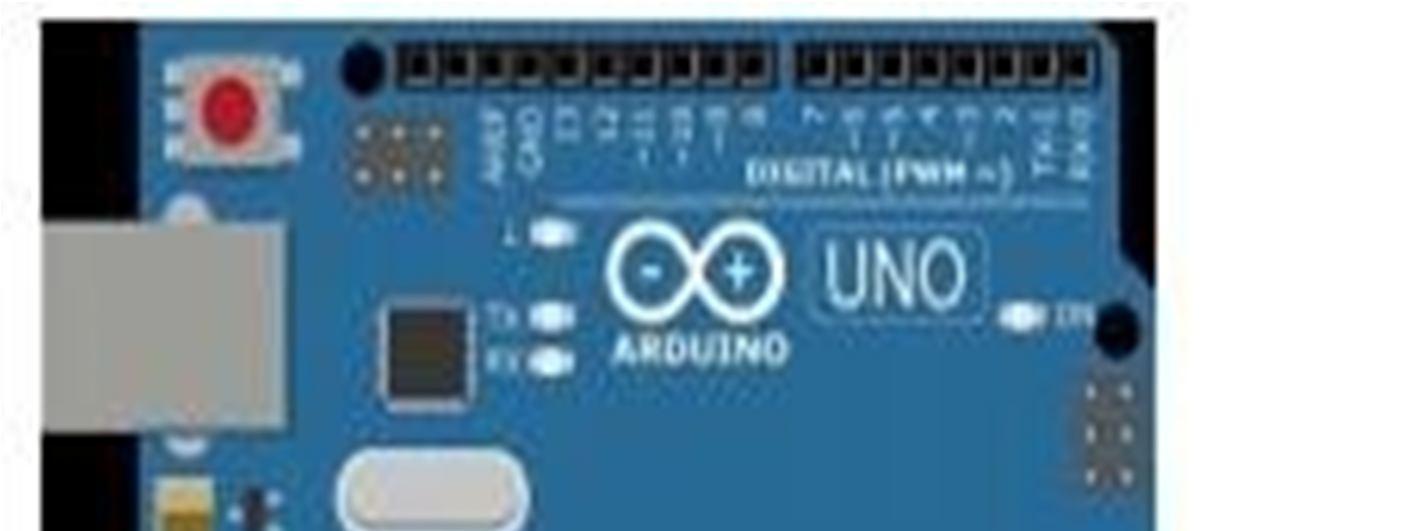
1) Step1: Things You need
2) Step 2: Schmatics Design of transmitter circuit design of receiver circuit
3) Step3: Code implementation Code uploading to arduino board
A. Components Required
1) For Transmitter
a) 434 MHz RF Transmitter Module
b) HT – 12E Encoder IC
c) 750 KΩ Resistor
d) Push Button
e) Power Supply
f) Connecting Wires
g) Prototypin Board (Bredboard)

2) For Receiver
a) Arduino UNO
b) 434 MHz RF Receiver Module
c) HT- 12D Decoder IC
d) 33 KΩ Resistor
e) Small Buzzer
f) Power Supply
g) Connecting Wires
h) Prototyping Board (Breadboard)


ISSN: 2321-9653; IC Value: 45.98; SJ Impact Factor: 7.538

Volume 11 Issue I Jan 2023- Available at www.ijraset.com
The Arduino Uno is an open- source micro controller based on the Microchip ATmega328p microcontroller and developed by Arduino. The board is equipped with sets of digital and analog input/output (I/O) pins that may be interfaced to various expansion boards (Shields) and other circuits. The Arduino Uno is an open-source micro controller ATmega328P microcontroller and developed by Arduino.cc The boards equipped with sets of digital and analog inputs/output (I/O) pins that maybe interfaced to various expansion boards (shields) and other circuits.
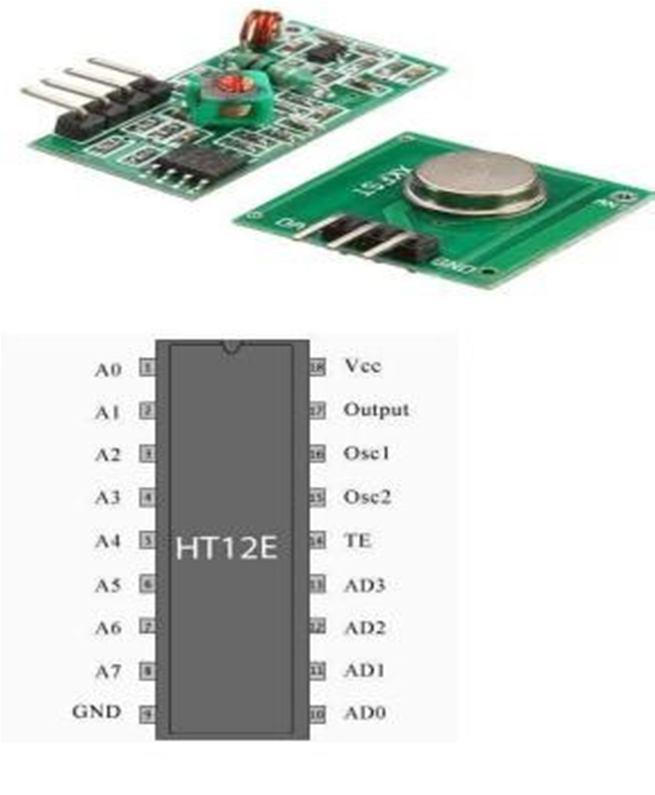
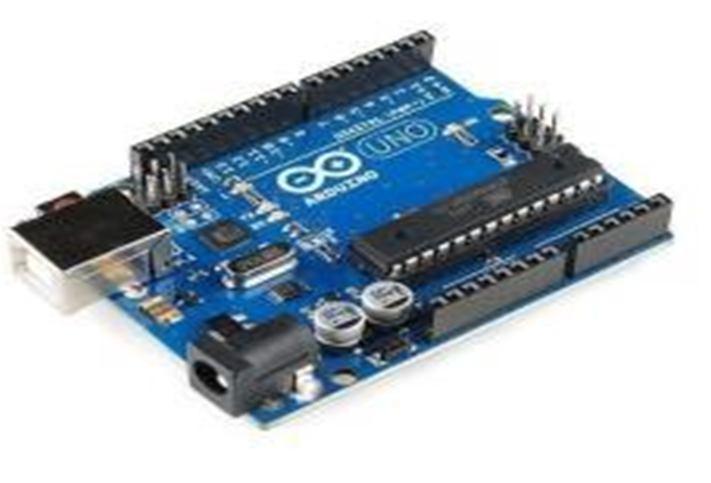

ISSN: 2321-9653; IC Value: 45.98; SJ Impact Factor: 7.538
Volume 11 Issue I Jan 2023- Available at www.ijraset.com
A breadboard is a solderless device for temporary prototype with electronics and test circuit designs. Most electronic components in electronic circuits can be interconnected by inserting their leads or terminals into the holes and then making connections through wires where appropriate.

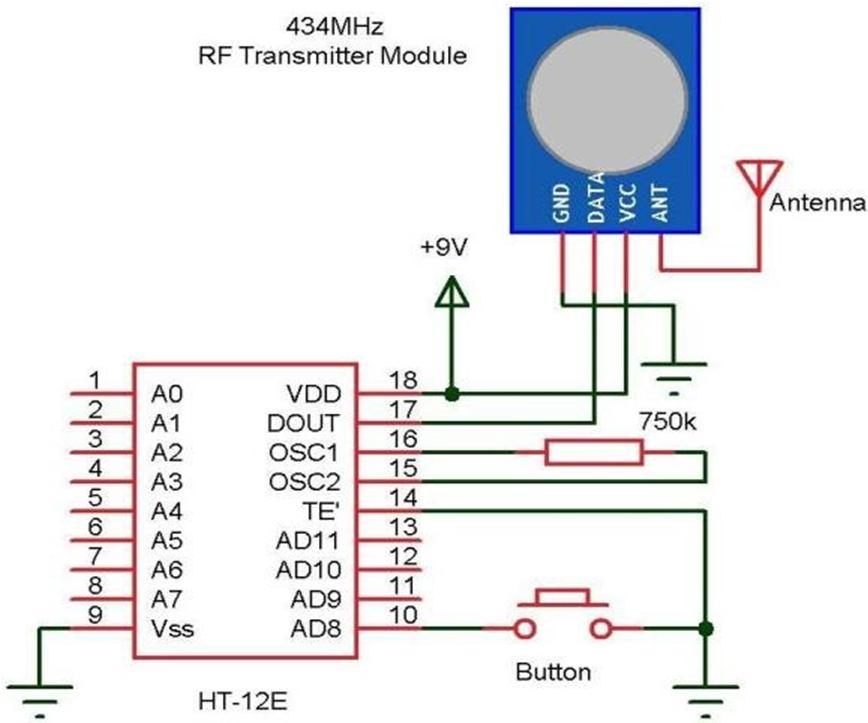
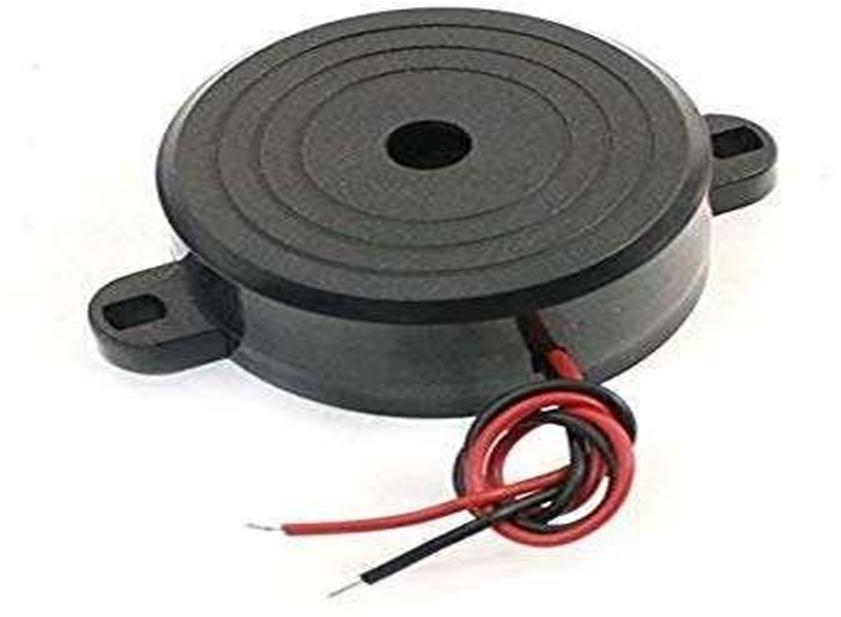

The wireless communication in this project is implemented using RF Transmitter – Receiver pair. A 434 MHz RF Transmitter –Receiver Module is used in this project. Up to 500 feet or 150 meters of distance can be possible with this module.
A buzzer or beeper is an audio signalling device, which may be mechanical, electromechanical, or piezoelectric (piezo for short)

ISSN: 2321-9653; IC Value: 45.98; SJ Impact Factor: 7.538
Volume 11 Issue I Jan 2023- Available at www.ijraset.com
The transmitter consists of a 434 MHz RF Transmitter Module, HT – 12E Encoder IC, 750 KΩ Resistor and a push button. The design of the transmitter circuit is very simple. Pins 18 and 9 are connected to supply and ground terminals respectively. The data out pin (Pin 17) of HT – 12E is connected to data pin of the RF Transmitter Module. A 750 KΩ is connected between the oscillator pins (Pins 15 and 16) of the HT – 12E. The transmission enable pin (Pin 14) is connected to ground. A push button is connected between AD8 (Pin 10) and ground. Other connections are shown in the circuit diagram.

The receiver part of the project consists of 434 MHz RF Receiver Module, HT – 12D Decoder IC, 33 KΩ Resistor, Arduino UNO and a small buzzer.Pins 18 and 9 i.e. VDD and Vss pins are connected to supply and ground terminals respectively. The data in pin (Pin 14) of the decoder IC is connected to the data pin of the RF Receiver Module. A 33 KΩ Resistor is connected between the oscillator pins (Pins 15 and 16) of the decoder ,The D8 pin (Pin 10) is connected to Pin 2 (or any digital I/O pin) of Arduino UNO. A small buzzer is connected between pin 11 of Arduino and ground.
The aim of this project is to design a simple wireless doorbell. The working of the project is explained here. For explaining the working of the project, all the connections are made as per the circuit diagram. Make sure that the Transmitter Part of the Project is switched on before the Receiver Part. This is to ensure that the RF Transmitter and Receiver Modules are properly paired. In order to ring the bell (or buzzer in this case), we need to push the button on the transmitter side of the circuit. When the button is pushed on the transmitter side, a logic ‘0’ will be detected by the Encoder IC. The Encoder IC will transmit this data serially through the RF Transmitter Module. The transmitted data will be received by the RF Receiver Module and is given to the Decoder IC. The Decoder IC, then decodes the serial data to parallel data and transmits the Logic ‘0’ to Arduino. In the Arduino UNO’s, it is programmed such that, whenever a Logic ‘0’ is detected by the Arduino, the buzzer is turned on. Hence, whenever the button is pressed, the buzzer is turned on wirelessly
H. Code void setup() { pinMode(14, INPUT); pinMode(11, OUTPUT); digitalWrite(11, LOW); } void loop() {
if(digitalRead(14)==LOW)
{
digitalWrite(11, HIGH); delay(1400); digitalWrite(11, LOW); delay(700); digitalWrite(11, HIGH); delay(1400); digitalWrite(11, LOW); delay(700); digitalWrite(11, HIGH); delay(1400); digitalWrite(11, LOW); delay(700);
} else { digitalWrite(11, LOW); } }
1) The advantage of using RF Transmitter – Receiver based Wireless Doorbell is that it is very easy to design the circuit and implement.
2) The range of the transmission is fairly large. Hence, it is suitable for large homes.
3) Another advantage over Bluetooth based data transmission is it doesn’t require any smart phone or Bluetooth enabled phone or any other Bluetooth device.
ISSN: 2321-9653; IC Value: 45.98; SJ Impact Factor: 7.538

Volume 11 Issue I Jan 2023- Available at www.ijraset.com
4) In case the system is implemented using a Wi-Fi network, we need to make sure that both the transmitter and receiver are connected to the Wi-Fi network.
5) Another wireless technology which can be used for Wireless Doorbell is IR. But the problem is that its range is less and also it is a Line of Sight Communication.
6) It has different penetration through the walls of the buildings or houses based on the frequency. Hence used for radio and television transmission and for cellular mobile phone service. • ➨Used in various medical applications.
7) It is used in Diathermy instrument for surgery.
8) It is used in MRI for taking images of human body.
9) It is also used for skin tightening.
10) It is used in radar for object detection.
11) It is used for satellite communication.
12) It is used in microwave line of sight communication system.
1) Uncontrolled radiation of RF affects preadolescent childrens, pregnant women, elderly humans, patients with pace makers, small birds, flora and fauna, small insects etc.
2) The areas near RF cellular towers have been observed with more lightening compare to other areas
3) It also affects some of the fruits grown near the RF tower areas.
4) As RF waves are available both in LOS and non LOS regions of transmitter, it can be easily intruded by the hackers and crucial personal/official data can be decoded for malicious motives. In order to avoid this situation, radio frequency wave based transmission is used with highly secured algorithms such as AES, WEP, WPA etc. RF signal can also be modulated either using frequency hopping or spread spectrum techniques to avoid this kind of eavesdropping.
5) The areas near RF cellular towers have been observed with more lightening compare to other areas.
6) It also affects some of the fruits grown near the RF tower areas.
7) As RF waves are available both in LOS and non LOS regions of transmitter, it can be easily intruded by the hackers and crucial personal/official data can be decoded for malicious motives. In order to avoid this situation, radio frequency wave based transmission is used with highly secured algorithms such as AES, WEP, WPA etc. RF signal can also be modulated either using frequency hopping or spread spectrum techniques to avoid this kind of eavesdropping.
1) Both the Transmitter and Receiver parts of the circuit must be always turned on i.e. there should always be power.
2) No additional security like camera integration and hence, the ringer of the bell can’t be determined.

1) The Wireless Doorbell implemented in this project is just a demonstration of the idea. But the idea can be extended to actual, real time wireless doorbell system.
2) Since the mode of communication is RF, the range is considerably large that other wireless technologies.
3) The project is suitable for homes, shops, garages, hospitals, offices etc.
We conclude that this automatic wireless doorbell is used for security purpose. It can be used not only in house hold but also in public places.
[1] https://www.electronicshub.org/wirelessdoor-bell/
[2] https://www.youtube.com/watch?v=_yiEAXdjJm4 - action=share
[3] https://circuitdigest.com/microcontrollerprojects/wireless-doorbell-using
[4] https://create.arduino.cc/projecthub/moham madsohail0008/touchless-doorbell
[5] Lucas M. Alvarez Hamann, Luis Lezcano Airaldi, Mariya E.Baez Monlinas, Mariano Rujana, Juliana Torre, Sergio Gramajo National technological UniversityResistencia faculty French 414, Resistencia,Chaco,Argentina “Smart doorbell: an ICT solution to enhance inclusion of disabled people”,978-92-61158217/CFP1538E-ART@2015ITU

ISSN: 2321-9653; IC Value: 45.98; SJ Impact Factor: 7.538
Volume 11 Issue I Jan 2023- Available at www.ijraset.com
[6] Janki venukumar, Naveen. S ,PG student,Dept.of ECE, LBS-Institute Of Technology for women, Trivedrum, India
[7] “Aurdino Based Door Access Control”.International Journal of Research in Advent Technology,vol.4,no.8,august2016.EISSN:2321-9637.
[8] Pushpanjali Kumari, Prathibha Goel, Dr. S.R.N. Reddy, CSE department, IGDTUW, Kashmere Gate, Delhi “IoT Based Wireless Alert System for Deaf and Hard of Hearing”,978-1-4673-97773/16$31.00@2016IEEE

